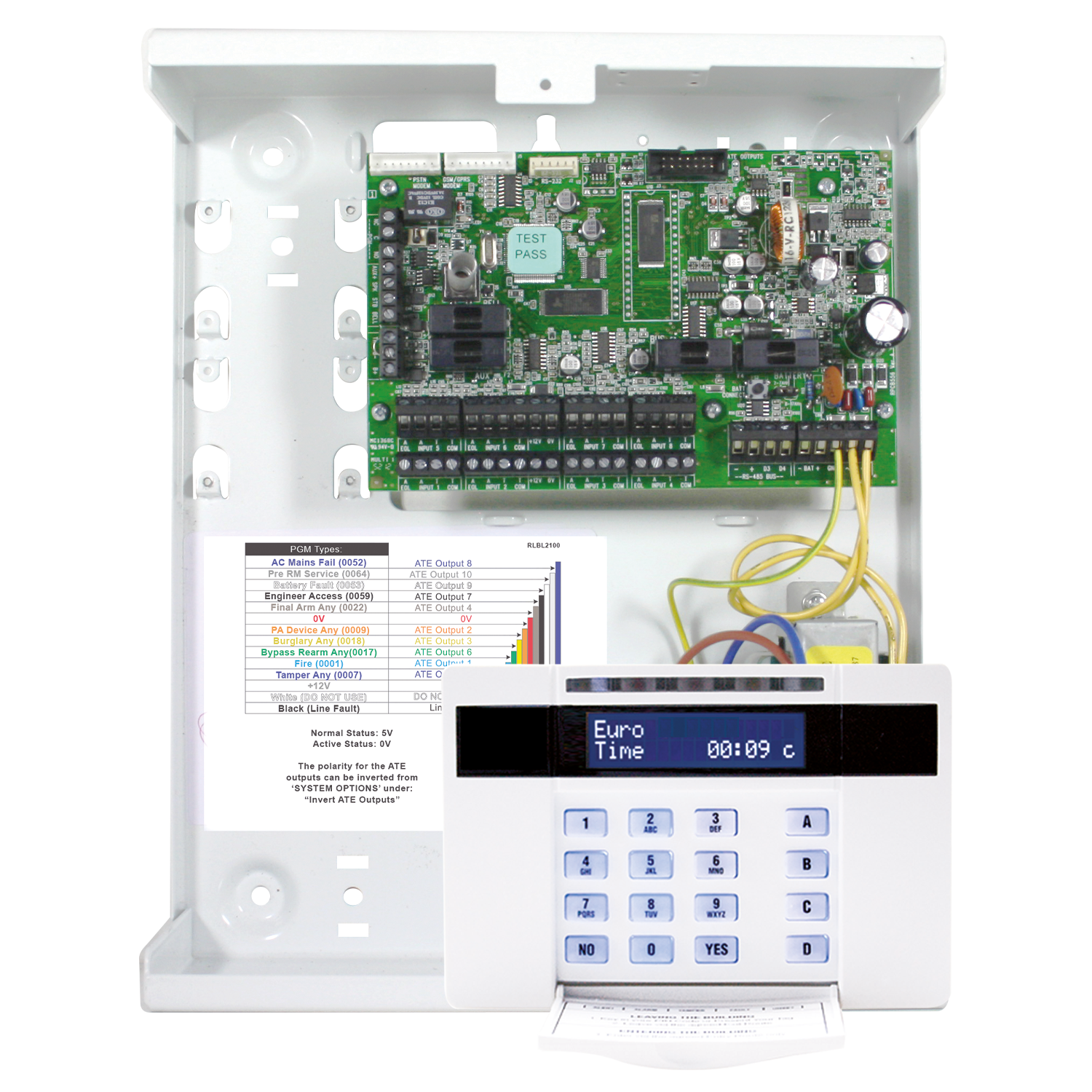
| Interchangable Words | Description |
| Armed, set | When an area or level is armed, if an zone is triggered, the system will follow the appropriate (programmable) actions. |
| Disarmed, unset | When an area or level is disarmed, the panel will not react unless specifically programmed to do so. |
| Siren, sounder, bell | A warning device (usually external) that is generally configurated to give audible and visual notification that the system has been activated. |
| Area, partition | A group of zones assigned to be active when that particular area is armed. This is usually named ‘Area A’ or renamed to a personal choice such as ‘Full Set’ or ‘Shop’. |
| Zone, input | This refers to a detector or sensor connected to the system, whether this be wired or wireless. |
| Output, PGM, PG | An output is a signal from the panel to instruct another device to operate. This is usually a voltage that triggers a wired siren, a garage door, a wireless siren etc. |
| Bypass, omit | The act of stopping an zone from becoming armed. A wired zone will still detect an intruder or object but the system will not react to it – a wireless zone will become dormant. |
This alarm system has been designed with your security in mind; with quick and easy installation and minimal maintenance, this system protects your home or property with a multitude of unique features.
As well as wired, this system can take full advantage of innovative two way wireless technology, with the the wireless devices on this system constantly communicating with each other using High Security Wireless Encryption Protocol.
Compared to conventional one way wireless systems, where devices can be ‘asleep’ for up to five minutes at a time, therefore compromising your security, this wireless technology ensures your safety at your home or office at any time.
This alarm system has been engineered to be secure, reliable and easy to use. It includes the following features:
Battery Supervision
Advanced technology preserves the battery life of each wireless device. However, the system informs you when a battery needs replacing upto a month in advance before the device stops working. This key feature gives you enough time to change the battery in the specific device. Conventional wireless alarm systems may not give you a low battery warning signal, meaning that devices could stop working, leaving your environment unprotected.
User Automation Outputs
These give you the option to operate up to 20 devices such as gates, lights, garden sprinklers, etc. via your keypad or remotely via your key fob, extending the use of your security system.
User Notification
Receive notice via SMS text message or push notification of any incidents within your home in real time. This can be programmed to send in different situations such as:
• System is set or unset: Notification that your child has returned home from school safely.
• Alarm activation: Notification that the alarm has been triggered, allowing you to monitor your home from anywhere in the world.
This alarm system has 6 areas which may be set up in the following way:
Area A: Full set of the house
Area B: Downstairs set. Upstairs unset.
Area C: Garage set. Rest of house unset.
Your engineer will be able to design the system according to your needs.
Additional wired keypads may also be connected to the alarm panel, please ask your engineer for more information.

= Exits the Master Manager Menu and selects Area A when arming.
= Moves backwards in the Master Manager Menu and selects Area B when arming.
= Enables chime, displays additional information in
the event log, and selects Area C when arming.
= Moves forward in the log, scrolls between options
and enters the Master Manager Menu and selects Area D when arming.
= Not used.
= Directional buttons and enables/disables functions.
= Selects commands.
= Cancels items, resets the panel and moves to next item in a menu item.
The external tag reader can be used for arming/disarming, entry control or access control. Ask your engineer for more details.
To arm/disarm the system using the external tag reader, present a pre-programmed tag to the centre of the device.
The device will display the system status:
Green = Unset
Red = Set
Present the tag again within 10 seconds and the system will arm or disarm.
The system will then arm depending on the type of exit mode programmed (Final Door, Timed or Push to set)
Arming and Disarming
If you are using a tag to arm/disarm the intruder system, press any key first (except ), to ‘wake’ the wireless arming station before presenting a tag.
Alternatively, if a user code is being used, please enter the code. The wireless arming station will automatically ‘wake’ once the first button is pressed.
After a tag or code has been accepted, choose the area to set by pressing the ,
,
or
keys. The key will illuminate indicating that area has been chosen to be set. Once confirmed, press the
key.
To disarm, enter the user code.
Activating the Outputs
Press the key and enter the Master Manager Code.
The keys
and
will illuminate.
The OP1 – OP4 LEDs will illuminate once the 1-4 numeric keys have been pressed. Once illuminated, it signifies that the output has triggered. Press the key again to deactivate the output.
For information on how these may have been programmed, please speak to your engineer.
Enter a valid PIN code or present a valid tag to the ‘tag symbol’ (which is to the left of the LCD screen).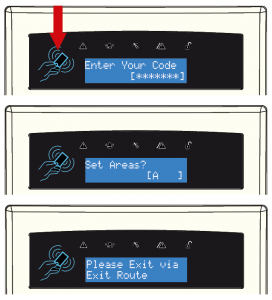
Enter the area you wish to arm, and press . ‘Please wait setting wireless’ will be displayed.
There are three different setting methods, your engineer will demonstrate the appropriate exit method for your installation:
Final Door: Once the exit time has started, leave the building and make sure the exit door is opened and then closed properly.
Timed: Make sure you leave the building before the timer shown on the keypad expires.
Push to set: Press the push to set button installed by your engineer to set the system.
Enter the building and the ‘entry time’ will start.
Enter a valid PIN code or present a valid tag to the ‘tag symbol’ (which is to the left of the LCD screen).
Level Set System
Press f and the area that the code is assigned to will be unset.
Area Set System
Select the area or areas you wish to unset then press .
Please note: If ‘flexi-unset’ is disabled then once a valid user code or tag is presented, the system will automatically disarm the levels or areas armed.
Enter a valid PIN code or present a valid tag to the ‘tag symbol’ (which is to the left of the LCD screen).
The alarm symbol will flash indicating there has been an alarm activation and the keypad will display which zone has activated.
Press to reset the system.
There are two types of readers that can be used with the alarm system – the internal tag reader (used for indoors only) and the external tag reader (used for both indoors and outdoors).
Tags for the readers need to be programmed through the ‘Edit Users’ function in the Master Manager menu. The internal and external readers can be both assigned to individual areas, this will need to be set up by your engineer.

The readers may be used for entry control, which means they can operate automatic locks for example, as well as arming and disarming the system. This can be set up by your engineer.

Entry Control Instructions
Arming: Present a valid tag to the reader, the GREEN LED will illuminate on the external reader, remove the tag, the door will unlock, then present the same tag within 10 seconds and the system will arm and the door will lock.
Disarming: Present a valid tag to the reader and then remove it, the status will be shown (the alarm symbol will illuminate indicating the system is armed on the internal reader and the RED LED on the external reader), present the same tag within 10 seconds again and the system will be disarmed, and the door will unlock. Once disarmed, the door can be unlocked.
Access Control/Entry Control: The readers can be used also for opening doors only without the ability to set and unset. Please contact your engineer for more information on this feature.
Please note: Both the internal and external tag readers use the same proximity tags that are used to set and unset on the keypad of the system.
Your engineer may have set up the system so that either an ‘Anti-Code’ or ‘Engineer Restore’ is required in order to fully reset the alarm system. What this means is that there will be certain conditions (specified by your engineer in the programming) that will require more than just your user code/tag to restore the system back to its normal state.
Please note: Your code will still silence the alarm, but it will not reset the system.
After alarm activation has occurred, enter a valid PIN code,
present a valid tag, or press on the key fob to silence the
alarm.
The keypad will display as shown to the right. It is essential to take note of the number, on the screen (including the ‘G’) and call your Alarm Receiving Centre (ARC).
Press .
Please note: If your alarm system is not monitored by an ARC, you will need to contact your engineer.
Upon calling the ARC, quote the full code displayed
(including the ‘G’) to the ARC. They will respond with the anti-code for your system.
Make sure that the time is displayed on the LCD and enter the anti-code given by the ARC. ‘Engineer Reset Performed’ will be displayed on the screen if entered correctly, press to return to the time. If this procedure does not work correctly, contact your engineer.
lternatively, the engineer may have just enabled ‘Engineer Restores’ and not anti-code. In this instance the keypad will display ‘Restore Required’. In this scenario, please contact your installation company and explain the situation.
Any faults that occur on the system will be easily recognised by the flashing ALERT LED.

To see what the fault is, enter a valid PIN code, present a valid tag, or press on the key fob.
Depending on how the system has been set up by your engineer, it may still be possible to set the system despite a fault being present. To do this, enter your PIN code or present a tag, select the area then press .
PLEASE NOTE: Any fault may affect the overall performance of your alarm control panel and therefore your engineer should be contacted for further assistance if any fault is active.
If ‘Unable To Set’ is displayed, it indicates that an input is open and the area where the input is should be checked for open windows, pets, movement etc.
If the problem cannot be solved contact your engineer, or omit the input.
The ‘chime’ can be used for any zone on the system and can be set up by your engineer.
To enable the chime on the keypad, when the time is displayed, press and ‘c’ will be displayed on the right side of the keypad display.
Press again to disable the chime feature.
On occasion, a detector may need to be isolated if a room is occupied. Enter your user code and press 
Once the exit time starts, press then select the zones that need to be omitted. Press
. After 10 seconds the exit time continues.
Please note: Zones have to be programmed so that they can be bypassed by your engineer for this feature to operate.
If a ‘Hold Up’ is needed, press and hold both and
(the length of time they need to be pressed is programmed by your engineer).
A ‘Hold Up’ alarm will be generated.
Please note: The ‘Hold Up’ facility needs to be enabled by your engineer (either silent or full alarm).
The Master Manager Menu has the following functions:
Please note: The options visible will depend on which modem is installed in the panel.
| Function | Description |
| SET DATE AND TIME | Programs the date and time. |
| OPERATE USER OUTPUTS | Activates/deactivates user automation outputs that are used to remotely activate devices, such as electronic gates & lights. |
| OMIT INPUTS | Omits any ‘24 hour’ zones only (except ‘Hold Up’ zones). |
| EDIT USERS | Adds/Edits/Deletes User PIN codes, tags and key fobs. |
| REVIEW LOGS | Displays all event log information. |
| SMS PHONEBOOK | If SMS text is enabled, there will be up to 10 mobile numbers that can be programmed to send SMS alarms. Please discuss this feature with your engineer if required (THIRD PARTY SIM CARDS ONLY). |
| SET UP APP DATA | If the ProControl+ App has been enabled, this function will control the settings. |
| MODULE SETUP | This option will change depending on which modem is installed in the system. It could display: ‘WI FI SETUP’, ‘GPRS SETUP’ or ‘LAN SETUP.’ |
| WALK TEST | Tests each zone. |
| SIREN TEST | Tests each external siren (wired or wireless). |
| DIAL OUT MENU | Calls the UDL software. |
| ALLOW ENGINEER MENU | Enables or Disables engineer access. |
| BLOCK UDL SET | Blocks remote setting from the PC software. |
| BLOCK UDL | Blocks uploading/downloading from the PC software. |
| SYSTEM SOUNDS DEMO | Demonstrates all the sounds of the alarm system. |
| EXIT MANAGER MODE | Exits the Master Manager Menu. |
Please note: The Master Manager code allows access to all the options above. A ‘user code’ has access to the ‘User Menu’ which includes the functions: ‘OPERATE USER OUTPUTS’, ‘CHANGE CODE’, ‘REVIEW LOGS’, ‘WALK TEST’, ‘SIREN TEST’, ‘ALLOW ENGINEER MENU’, and ‘EXIT USER MENU’.
Press .
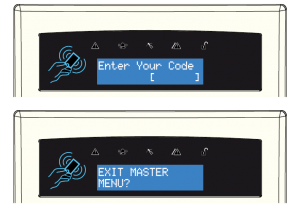
Enter the Master Manager Code or present the Master Manager Tag.
Press or
to scroll through the different functions mentioned above.
Press or
keys to scroll through until ‘EXIT MANAGER MODE’ is displayed. Press
.
Or to exit the menu, when a main item is displayed (capital letters) press .
| Press |
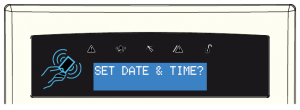 |
| Enter the Year. Press |
 |
| Enter the Month. Press |
 |
| Enter the Day. Press |
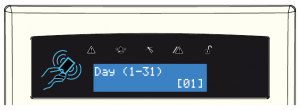 |
| Enter the Hours. Press |
 |
| Enter the Minutes. Press |
 |
| DST (Daylight Saving Time) adjust. Use |
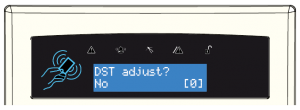 |
Use or
to scroll to ‘OPERATE
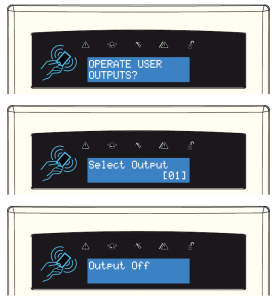
USER OUTPUTS’. Press .
Select the output to be operated by using the and
keys and press
.
Please note: The output to be operated can also be entered using the numerical keys.
Press trigger output on and off.
Press to exit.
Repeat if necessary.
Press or
to scroll to ‘OMIT INPUTS’. Press
.

Enter the zones you require to be omitted for the next setting procedure. Press .
Please note: All zones
The ‘EDIT USERS’ function allows adding, editing and deleting of user codes, tags and key fobs. The Master Manager Code can also be changed. The control panel can have up to 75 users.
PLEASE NOTE: Any proximity tags that are to be used on a standalone tag reader must have flexi-set set to ‘No’.
| Press |
 |
| To add a new code or tag press Press Press |
 |
| Enter the new code or present a tag. Once ‘asterisks’ appear, the tag or user code will be now assigned to this user. Press |
 |
| Press Please note: This screen will not be displayed if you have programmed a wireless key fob. |
 |
| Select the areas that the user will be assigned to: 0,1, A, B, C or D. Press |
 |
| Press Please note: This screen will not be displayed if you have programmed a wireless key fob. |
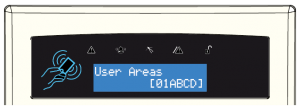 |
| Press |
 |
| Enter the user name and press |
 |
| Repeat to add more users. | 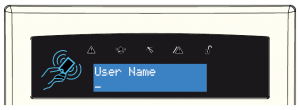 |
PLEASE NOTE: For instructions on adding a key fob please refer to the manual provided with the product.
| Press |
 |
| Press |
 |
| Press |
 |
| Press |
 |
To edit the Master Manager Code, press .

Enter the new code or present a tag. Press .
Refer to the section ‘Adding New Users’ for the options which will follow the code change.
The ‘Review Logs’ function monitors all operational information of the alarm system, such as arm/disarm information and alarm activations etc.
| Press |
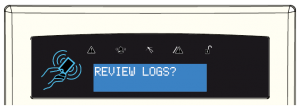 |
| Press |
 |
| The most recent event will be displayed, press |
 |
| Press the |
 |
Follow the information below to connect the alarm system to the PyronixCloud.
Please note: This menu will only be visible with a ProControl+ compatible module installed.
| Press |
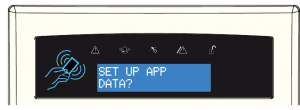 |
| Press |
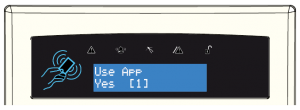 |
| Please take note of the ‘System ID’. This will be needed for the ProControl+ App set up. Press |
 |
| Create a cloud password. This is the password used when adding this panel to a PyronixCloud account. Press |
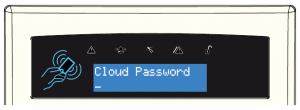 |
| NORMAL SECURITY LEVEL Press |
 |
| Create an App Password. This must be entered when using the ProControl+App in order to connect to the system. Press |
 |
| Press Please note: ‘Yes’ is recommended. |
 |
| HIGH SECURITY LEVEL Press |
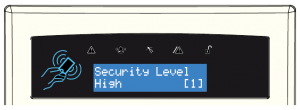 |
| Press |
 |
| Please take note of the key (part 1 is shown, press |
 |
| Press |
 |
| Rather than inputting the 32 character high security password into the App, you can send the password to a mobile phone and copy and paste it from the text. Press |
 |
| Press |
 |
*PLEASE NOTE: This function only available when using 3rd Party SIM cards only.
The password key is sent to your mobile phone as SMS message. UK numbers can be entered with or without an international dialling code (e.g. +44).
If you need to enter an international dialling code to send the key to a foreign SIM card, use the key to enter the ‘+’ symbol.
The type of module installed in your alarm system will determine which menu is shown here. This menu is used to program the module so that it can send and receive data whether that be via router or mobile data.
The connection of the module would typically be set up by the engineer on installation and if that has been done it is not recommended that the existing programming in this menu be changed.
Please refer to the ‘Communications Guide’ for more details on this menu.
If SMS text is programmed, there can be up to 10 mobile numbers also programmed which can be changed in this function. If “do not use” is shown on the display of a number, then a telephone number already exists that is communicating to an Alarm Receiving Centre (this can only be changed by your engineer).
| Press |
 |
| Press |
 |
| Enter the mobile number. Press Press |
 |
The ‘Walk Test’ function allows the testing of all programmed zones on the alarm system.
| Press |
 |
| Select which level/area to walk test. Press Please note: Only select one area to walk test at a time. |
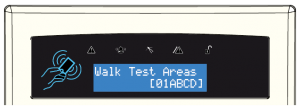 |
| Walk test the zones scrolling on the display. After all zones have been walk tested successfully ‘Walk Test Completed’ will be displayed. |  |
| Walk Test Individual Zones Press |
 |
This function is used to test the siren and strobe outputs.
| Press |
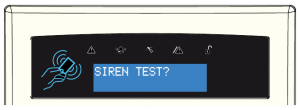 |
| Press |
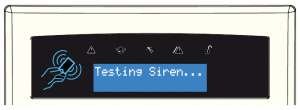 |
This function is used to force the panel to dial out to UDL software.
Do not use this function unless you have been instructed to by your engineer.
If this function is set to ‘No’, the engineer will require authorisation from you (by changing it back to ‘Yes’ before they can access the engineer menu).
| Press the |
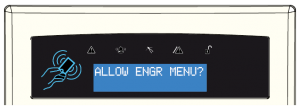 |
| Press |
 |
If this function is set to ‘No’, the engineer will require authorisation from you (by changing it back to ‘Yes’ before they can access the engineer menu).
| Press the |
 |
| Press |
 |
Your alarm system may be configured so that your alarm installation company can upload and download into the control panel. Should you wish to block this access, and you can enable this function.
| Use the |
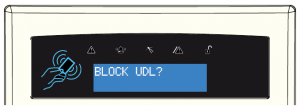 |
| Press |
 |
This function showcases all of the sounds that may occur during operation of the system.
| Use the |
 |
| Press |
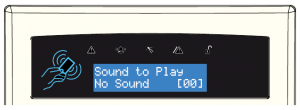 |
Notifications can be viewed in your ProControl+ App by touching the envelope icon names ‘Message’. When a new notification is available, the icon will display a red circle with the number of new messages.


Your panel is suitable for use in installations designed to meet the European requirements of Security Grade 2, Environmental Class II. When all parts are working normally, this equipment in combination with the PSTN or GSM and suitable ARC equipment will meet the requirements of ATS2 /LAN or Wi-Fi or GPRS meet the requirements of ATS5.
External readers and sirens meet the requirements of environmental class 4.
Number of Code Differs: Tag hex code.
Your panel is designed to automatically inhibit certain functionality. The factory default settings are shown below:
Intruder Alarm Signal
After 3* unconfirmed alarms in the same area or 1 confirmed alarm.
* This figure is programmable by the Engineer.
Tamper Alarm Signal
After 3* unconfirmed alarms in the same area or 1 confirmed alarm.
* This figure is programmable by the Engineer.
Keypad
After 30 key presses without entering a valid code, keys are disabled for 90 seconds. After reinstatement, this will be repeated after each 7 key presses until a valid code is entered.
Tag Reader (or tag at a keypad)
If an invalid tag is presented 6 times without a valid tag presented, the respective keypad or reader will be disabled for 90 seconds. After reinstatement, this state will be repeated after 2 invalid tags are presented to any reader.
All wireless devices comply with the following EU requirements:
| EMC Directive | 2014/30/EU |
| Low Voltage | 2014/35/EU |
| RE Directive | 2014/53/EU |
And meet the following standards where relevant:
| EN 61000-6-3:2007 +A1:2011 | EMC. Generic emission standard. Residential, commercial and light industry |
| EN 50130-4:2011 +A1:2014 | Immunity requirements for components of fire, intruder and social Wireless Alarm Systems |
| EN 60950-1:2006 +A12:2012 | Information technology equipment. Safety. General requirements |
| EN 50131-5-3:2005+ A1:2008 | Grade 2. Interconnections for equipment using radio frequency techniques |
| ETSI EN 301489-3 | EMC. Radio equipment. Part 3: Short range devices (SRD) 9kHz to 40GHz |
| ETSI EN 300 220 | EMC. Receiver Class 1, Environmental Category 1 |
| CEPT/ERC | Recommendation 70-03 Annex 1 |
Compliant operation is only guaranteed when installed and operated according to the relevant installation and user manuals.
For electrical products sold within the European Community: At the end of the electrical product’s useful life, it should not be disposed of with household waste. Please recycle where facilities exist. Check with your Local Authority or retailer for recycling advice in your country. When disposing of the product the batteries must be removed and disposed of separately in accordance with the local regulations.
PD6662:2017+IA501:2015
EN50131-1:2008+A1:2009
EN50131-3:2009
Security Grade (SG) 3 – Large
Security Grade (SG) 2 – Small
Environmental Class (EC) II